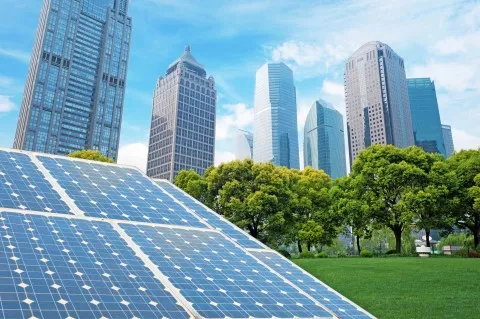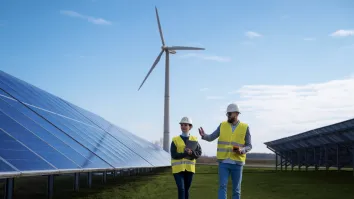
China retains crown as most attractive renewable energy market
It accounted for 35% of global solar capacity with 172GW in 2018.
Despite subsidy cuts which dramatically stalled the growth of solar installations, China retained the global distinction as the most attractive renewable energy market in 2019, according to EY’s latest Renewable Energy Country Attractiveness Index (RECAI) report.
The report, which ranks 40 countries on the attractiveness of their renewable energy investment and deployment opportunities, found that whilst policy-makers in China have reversed course on some of their harshest moves to slow the sector, they are also moving forward with measures to encourage subsidy-free development, demonstrating the growing viability of clean energy technologies.
Also read: China's State Development & Investment Corporation quits coal
In 2018, solar photovoltaic (PV) additions fell to 44.3GW, from a record 53GW in 2017, triggered by a reduction in subsidies. The country added 20.6GW of new wind power, compared with 15GW in 2017.
By the end of 2018, China accounted for 35% of global solar capacity, with 172GW, and 32% of total wind capacity, with 181GW.
“However, as it moves away from its expensive feed-in tariff (FiT) regime towards unsubsidised energy, the rate of solar additions is likely to moderate, according to analysis from Fitch Solutions, whilst those from wind are likely to increase,” Alex Zhu, EY’s Greater China power & utilities market segment leader and partner for corporate finance, explained. Fitch Solutions estimates that solar capacity will grow at an annual average of 36GW between 2019 and 2028, whilst wind will grow at an average of 23GW/year.
Chinese developers are not being cut off from subsidies entirely yet, he noted.
“In solar, regulators are once more approving ground-mounted projects, after halting approvals in June 2018 in a bid to reduce subsidy bills, at which point there was a backlog of at least $18b (RMB120b) in unpaid subsidy payments, and to achieve lower curtailment levels,” Zhu added.
According to Citigroup, China is expected to allocate around $400m (RMB3b) of subsidies to solar projects in 2019, and it forecasts 42GW of new capacity under its base case, with the potential to rise to 50GW.
Also read: China greenlights first round of subsidy-free wind and solar projects
Meanwhile, the Chinese government reportedly continues to support wind energy through its FiT regime, although rates are continuing to decline. Since 2017, the tariffs have decreased by 5% to 15%, depending on an area’s wind resource. Authorities are also actively supporting its offshore wind sector, which continues to qualify for attractive subsidies.
The government is also promoting subsidy-free renewables projects as technology costs fall, EY noted, with the National Energy Administration (NEA) proposing to set up an auction system, backed by 20-year offtake contracts, guaranteed grid connections, lower transmission fees, protection against curtailment, and eligibility for an expanded green certificate programme, amongst other things.
“Qualifying projects would be expected to sell power at the same price as non-subsidised coal-fired plants,” Zhu added.
EY further noted that one landmark planned project is the giant 6GW Ulanqab Wind Power Base, which is a series of wind farms in Inner Mongolia under development by the State Power Investment Corporation at a cost of $6.3b (RMB42.5b). The scheme will supply power to the 2022 Winter Olympics, to be held in Beijing and neighbouring Hebei province.
Another landmark development is the country’s first large, concentrated solar power and energy storage project, at 100MW and 390GWh, using a 260m-tall tower on the fringes of the Gobi Desert.
A report by Fitch Solutions added that crucial to the success of unsubsidised projects will be China’s ability to reduce wastage where transmission constraints have prevented renewable energy projects dispatching power and reducing the revenue they can earn.
“Provincial grid operators have tended to favour coal over renewables, as the former is cheaper than subsidised renewable energy. Curtailment rates have been falling in solar, from 6% in 2017 to 3% in 2018, which, if it continues, will make unsubsidised projects increasingly economically viable,” Zhu highlighted.
To date, foreign investors have had little involvement in China’s renewables sector, with overseas investment accounting for less than 1% of the total, EY noted. The move comes as international funders have steered clear of the market after bruising experiences around the turn of the century, when the national power company gave preferential treatment to domestically owned generating assets during a period of oversupply, and pushed foreign investors – mostly in coal-fired plants – to divest from China.
However, improved market practices and transparency are tempting investors back, this time into renewables.
“In 2017, for example, French utility ENGIE took a 30% stake in Unisun, a Chinese PV firm, whilst Total, the French oil major, last year helped seed, with two local partners, a China-focused clean energy fund,” Zhu noted. French power giant EDF is also said to have more than 400MW of clean energy capacity under construction or in operation in China, and has announced its first investment in the country’s offshore wind sector in March, with stakes in two projects totalling 500MW capacity.
Also read: EDF Renewables buys majority stake in rooftop solar portfolio in China
In the solar rooftop space, Canada-based Brookfield Asset Management and Japanese logistics provider GLP formed a joint venture last year, to install 300MW in three years using a third-party ownership model.
“China’s renewable energy market is, without doubt, undergoing a transition as the government seeks to rein in the costs of subsidies. With continuing concerns about pollution, falling technology costs, and revived interest from international players, however, growth in the world’s largest clean energy market is set to continue,” Zhu highlighted.



















 Advertise
Advertise







